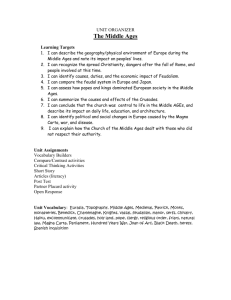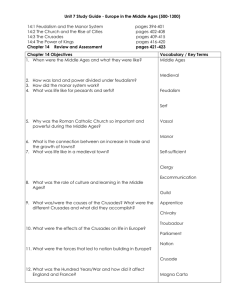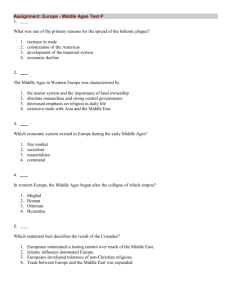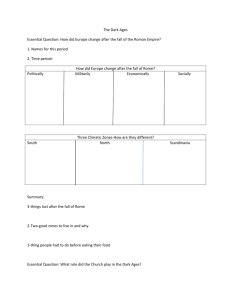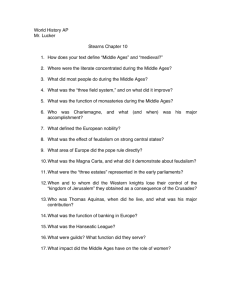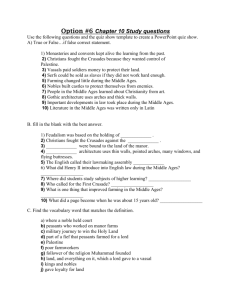Chapter 10 Lesson 1: Feudalism Define Feudalism: Vassal: Knight
advertisement
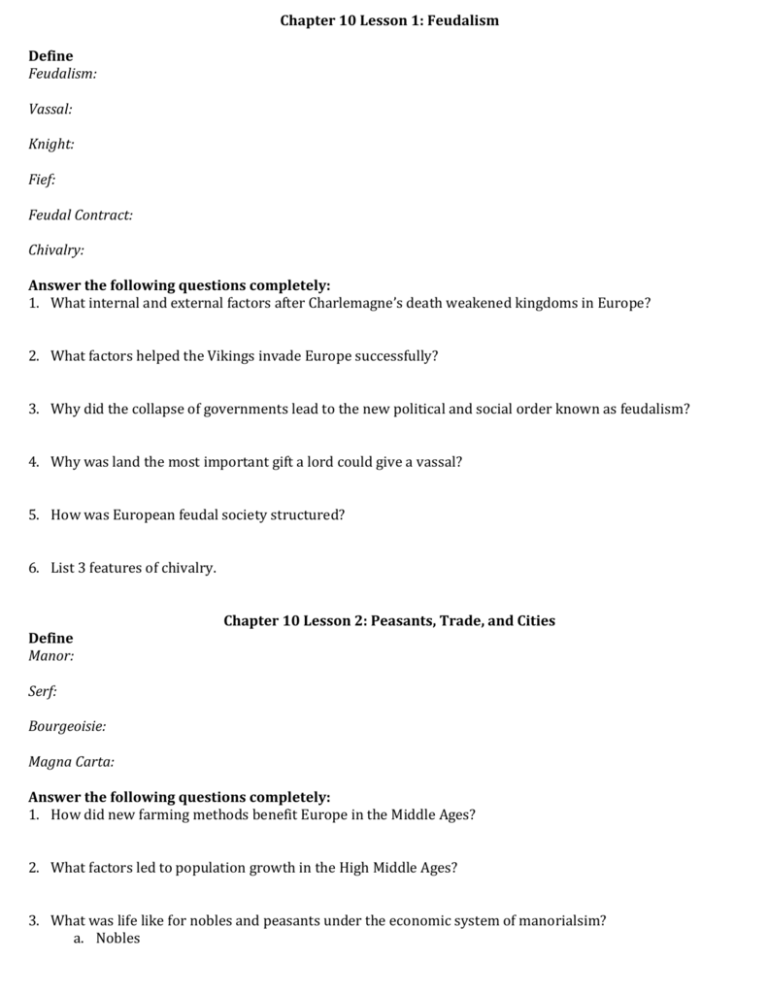
Chapter 10 Lesson 1: Feudalism Define Feudalism: Vassal: Knight: Fief: Feudal Contract: Chivalry: Answer the following questions completely: 1. What internal and external factors after Charlemagne’s death weakened kingdoms in Europe? 2. What factors helped the Vikings invade Europe successfully? 3. Why did the collapse of governments lead to the new political and social order known as feudalism? 4. Why was land the most important gift a lord could give a vassal? 5. How was European feudal society structured? 6. List 3 features of chivalry. Define Manor: Chapter 10 Lesson 2: Peasants, Trade, and Cities Serf: Bourgeoisie: Magna Carta: Answer the following questions completely: 1. How did new farming methods benefit Europe in the Middle Ages? 2. What factors led to population growth in the High Middle Ages? 3. What was life like for nobles and peasants under the economic system of manorialsim? a. Nobles b. Peasants 4. How were serfs legally bound to the land? 5. How did the revival of trade result in a commercial revolution during the Middle Ages? 6. Why were towns of Flanders busy trading centers? 7. What spurred the growth of cities in the Middle Ages? 8. What role did guilds plat in the economic life of towns and cities? Define: Lay investiture: Chapter 12 Lesson 1: Medieval Christianity Interdict: Sacrament: Heresy: Relics: Answer the following questions completely: 1. How did the political power of the Catholic Church change between the papacies of Pope Gregory VIII and Pope Innocent III? 2. Why was the Concordat of Worms an important turning point for the Catholic Church? 3. What effects did the new religious orders formed after 1098 have on medieval Europe? 4. What led to the creation of the Cistercian order? Explain how it was different from the Benedictine order. 5. How did religion influence the daily lives of people in the High Middle Ages? 6. Why were relics important to Christians living in Europe during the Middle Ages Chapter 12 Lesson 2: The Crusades Define: Crusades: Answer the following questions completely: 1. What were the motivation behind the Crusades a. Religious: b. Political: c. Economic: 2. How did the Crusades affect Europe and Southwest Asia? Define: Theology: Chapter 12 Lesson 3: Culture of Middle Ages Scholasticism: Vernacular: Answer the following questions completely: 1. How did innovations change the architecture of churches and cathedrals in the High Middle Ages? 2. What are the differences between Romanesque and Gothic architecture? 3. How did universities reflect the intellectual revival that occurred in Europe during the High Middle Ages? 4. What were 2 popular types of vernacular literature in the 12th century? Define: Anti-Semitism: Chapter 12 Lesson 4: The Late Middle Ages Answer the following questions completely: 1. What social and economic effects did the Black Death have on Europe? 2. What caused the plague? 3. How did the Great Schism and other crises lead to the decline of Church power? 4. Why were Popes living in Avignon criticized? 5. Why was the Hundred Years’ War a turning point in warfare, and what were its consequences? 6. What event sparked the Hundred Years’ War? 7. What kind of political recovery occurred in Europe in the 1400s? 8. What type of government had France, England, and Spain developed by the end of the 1400s?

